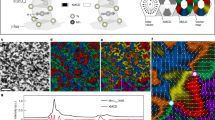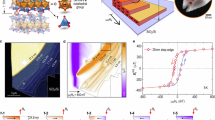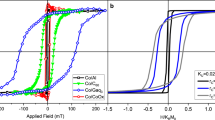Abstract
The stability of data bits in magnetic recording media1,2 at ultra-high densities is compromised by the thermal ‘flips’—magnetic spin reversals—of nano-sized spin domains3, which erase the stored information. Media that are magnetized perpendicular to the plane of the film, such as ultrathin cobalt films or multilayered structures4,5, are more stable against thermal self-erasure2,6 than conventional memory devices. In this context, magneto-optical memories seem particularly promising for ultrahigh-density recording on portable disks, and bit densities of ∼100 Gbit inch-2 (ref. 7) have been demonstrated using recent advances in the bit writing and reading techniques7,8,9,10,11. But the roughness and mobility of the magnetic domain walls12,13 prevents closer packing of the magnetic bits, and therefore presents a challenge to reaching even higher bit densities. Here we report that the strain imposed by a linear defect in a magnetic thin film can smooth rough domain walls over regions hundreds of micrometres in size, and halt their motion. A scaling analysis of this process, based on the generic physics of disorder-controlled elastic lines14,15,16,17, points to a simple way by which magnetic media might be prepared that can store data at densities in excess of 1 Tbit inch-2.
Similar content being viewed by others
Main
Increasing information storage to densities past 100 Gbit inch-2 may evolve through extensions of current magnetic recording technologies (to patterned media6, for example). But such increases in storage density might be achieved by using other techniques such as holography (via interference patterns produced by two intersecting laser beams)18, or micromachined nano-cantilever arrays19, or—to satisfy a relentless demand for portability—using scanning localized subwavelength (<λ/40) (near-field) optical probes9 that can imprint and resolve images in magneto-optic media7 of the order of the probe size. The bit-writing with local probes may be thermally assisted by a current20 or a laser beam that raises local temperature to the vicinity of the Curie temperature TC, resulting in the formation of a reversed domain with a rough wall. To realize smooth and (for precise positioning) stable (‘noiseless’) domain walls that can be implemented without, for example, nanoscale patterning, we suggest a conceptual identification of walls with elastic lines16 and seek to use linear defects inducing a directional long-range strain field in ultrathin Pt/Co/Pt structures—long considered excellent candidates for high-density recording at blue-range wavelengths11. In such trilayers (Fig. 1), large uniaxial perpendicular anisotropy is sustained by the interface contribution proportional to 1/dCo up to Co thickness dCo ≈ 1.5 nm; beyond this thickness the magnetization switches from out-of-plane to in-plane5.
Figure 2a shows two typical up-domains (see legend for imaging details21), nucleated owing to a locally suppressed coercive field3 Hc in a 0.7-nm Co film sandwiched between 3-nm (top) and 2-nm (bottom) Pt layers, prepared using standard deposition parameters22 and without linear defects. The domains are round, with (undirected) domain walls (DWs) that are as rugged as expected12. We note that patterned nucleation sites, as in Fig. 2b–d, do not reduce either DW roughness or velocity. As magnetic field is increased beyond Hc = 750 Oe (inset in Fig. 3), the outward motion of DWs becomes increasingly swift (estimated from displacement of a small segment of the wall during 500-ms field pulses, the wall velocity is more than 180 µm s-1 at H = 854 Oe).
Polar magneto-optic Kerr microscopy3 images were obtained using a 3-W argon laser illumination (λ = 514.5 nm and 488.0 nm) to enhance phase contrast with a laser-beam tandem-dithering technique21 to eliminate the effects of laser coherence. We first saturated magnetization with a negative z-axis magnetic field and then quenched the field to zero. After a first positive square field pulse, an up-domain was nucleated and its motion was imaged at short time intervals in fields up to ∼2 kOe. a, Typical room-temperature image of domains in a film without line defects after a 854-Oe magnetic field applied for 1 s was removed. The walls show roughness on length scales much larger than the grain size (∼20–30 nm) of the Pt buffer. The rapid motion of domain walls (DWs) is illustrated in snapshots in field H = 616 Oe after b 1 s, c, 4 s and d, 8 s of DWs that were seeded with elongated defects installed with a 30-keV Ga+ FIB (focused ion beam). DW roughness is independent of the seed-defect width (150 nm for bottom and 1 µm for top domains). e, f, A remarkable reduction in the domain wall roughness and speed is illustrated when a line-defect (dashed line along y axis) is introduced. The images here were taken at H = 924 Oe (>HC = 750 Oe in a) at e, 40 s and f, 1,800 s. The domain wall becomes directed along the defect. A cross-sectional electron transmission micrograph (g) of an ∼30-nm-thin FIBed section—normal to the line-defect—shows an asymmetric ‘fold’ of the trilayer stack. An amorphous Pt (a-Pt) cap was deposited to protect the trilayer during the FIB process. The ∼10-nm elevation of Co in the ‘fold’ is traced by the X-ray microprobe (h) at spots such as are marked by six white circles in g (the bottom is assigned ‘0’). Co intensity versus spot number is plotted in the inset of h.
Far away (-578 µm) from the line-defect ‘ridge’ at x = 0, the velocity takes off rapidly with field near Hcrit. Well below Hcrit, the nonlinear v–H curves follow13 v(H) ∝ exp[-Up/kBT)(Hcrit/H)μ], where Up is the collective pinning energy scale, kB is the Boltzmann constant, T is temperature, and μ = 1/4 is the glassy dynamical exponent related to the roughness exponent; see ref. 14. Hcrit grows on the approach to the line defect (see Fig. 4a). Inset, a square Kerr rotation (magnetization) hysteresis characteristic of perpendicular anisotropy of our film in Fig. 2a.
To control the rugged DW structure we will use a recently found connection between the DW behaviour in thin films13 and that of elastic lines14,15,16. One prominent example of directed elastic lines are wandering vortex lines (quantized magnetic flux lines maintained by a swirling tube of current) in high-temperature superconductors16 that can be strongly localized by interaction with columnar (linear) defects17. A powerful arsenal of ideas can now be engaged to understand how a linear defect potential may localize and reduce the roughness of DWs, and force them to accommodate to the defect shape. We introduce a line defect that delivers a three-punch action. Through magneto-elastic coupling, (1) it gives the wall a preferred direction14 (along the defect), (2) it increases its elasticity, reducing the DW roughness as it negotiates the random landscape, and (3) it acts to reduce wall velocity to a nearly full stop in fields greater than the coercive field of unmodified film. The defect is installed during the Co deposition by imposing an anisotropic tension (clamping) on the substrate and its subsequent release23. The resulting Co ‘fold’ (Fig. 2g, h) introduces a y-axis-invariant long-range strain field ε(x).
A DW driven by the magnetic field toward such a linear defect (Fig. 2e, f) presents a structural contrast with the DWs in the unmodified film in Fig. 2a. Even at large distances (∼300 µm) away from the defect, the DW conforms on the average to the defect line along y. It becomes progressively smoother (and straighter) as it approaches the defect. It also rapidly decelerates. The deceleration and near-standstill of the wall depends on the proximity to the defect, as represented by the spatial progression of the velocity-versus-field (force) response in Fig. 3. The v–H curves are highly nonlinear, as has been reported recently in Co films13 where the disorder landscape is formed, for example, by atomic-scale imperfections at the film–substrate interface. Such nonlinear response in the limit of vanishing driving force is a signature of glassy (creep) dynamics24, well established for the elastic vortex lines in a superconductor through measurements of the voltage-versus-current (V–I) characteristics16. Above Hcrit (obtained from the v–H curves by the usual velocity cut-off criterion, here chosen at v = 0.14 µm s-1) the driving field exceeds the ‘pinning’ force16 and the DW response becomes linear and faster. We note that DW velocity, even far away from a line defect, is orders of magnitude lower than in unmodified films. Figure 3 shows a field-forward advance of v–H curves to higher fields, and an enhanced Hcrit (often referred to as a ‘propagation field’3) on the approach to the line defect. An effective potential well that localizes the wall is formed by the driving field pushing the wall and the line-defect that acts against this push. It resembles columnar defects in a superconductor, where the critical current Jcrit is enhanced17. Hcrit correlates with the long-range repelling force field H(x) exerted on the DWs by the line-defect, whose spatial extent is mapped in Fig. 4a. The shape of H(x)—a ridge along y—is either extracted directly from Kerr images taken with increasing H after a fixed propagation time t (main panel), or more quantitatively from the averaged DW positions 〈x〉y versus time at all fields. As illustrated in the inset, it takes a higher field H to get closer to the line-defect; but at any H, after t = 1,800 s, two DWs—one approaching the ridge from the left and another from the right—become effectively stationary.
a, A fixed y-cut from a map of the defect ridge obtained from combining domain images for different fields after 400 s. To display the long range (x = -680 to +140 µm) of the force field of the line defect, we overlapped two series of Kerr observations (H = 700 to 1,316 Oe): one containing a line defect at x = 0 (as in the inset) and another shifted to the left by 400 µm. The ridge is mapped by imaging two domains approaching it from both sides. Contours (at 20-s intervals) of the defect field (inset) that were obtained by extracting DW positions at different times and fields show how two DWs on two sides of the ridge become stationary when the defect field balances the driving field, defining the ridge's outline. The propagation field Hcrit (solid blue dots), obtained from v–H curves in Fig. 3 is enhanced by the line defect. The line defect effectively enhances (b) the anisotropy constant K′eff and elongates (c) the scaling length Lp.
Within the elastic description of a DW, the relevant scale is a collective pinning24 length Lp = (ε2elξ2/Δ)1/3, where ξ and Δ are characteristic size and strength of underlying random disorder, and εel is the wall energy. At lengths L > Lp, the wall will elastically adjust to the random landscape to nestle in a local minimum energy configuration. The DW energy density (in addition to a uniform field term and ignoring a weak dipolar term) can be written as a sum of three: the exchange energy γex(x), the anisotropy energy γan(x), and the magneto-elastic energy25 γm-el(x) coupling to the strain ε(x) generated by the line-defect,

Here A is the exchange stiffness3, K′ = K - 2πM2s (where K is the anisotropy constant and Ms is Pt-polarization-enhanced saturation magnetization of Co), and B is related to Young's modulus of the film. Magnetization M rotates from ‘up’ to ‘down’ within the wall thickness δ (we estimate at ∼3 nm) and the wall (in the simplest form) is of Bloch type13, where the azimuthal angle φ = 0° and the rotation is parameterized by an angle θ between the z axis and M (mz is the direction cosine along z). Minimizing ∫γDWdx leads to DW energy3 εDW = 4√AK′eff, where K′eff = K′ + Bε(x). The total wall energy (per unit area) in a magnetic field H is ε = εDW - 2MsHx. From the stability condition dε/dx = 0 we obtain a nonlinear differential equation for ε(x): H(x) = AM-1sB(dε/dx)(AK′eff)-1/2, which we solve numerically using the stationary H(x) mapped in Fig. 4a. The result is a factor of ∼2 enhanced effective anisotropy K′eff (Fig. 4b) and, consequently, an enhanced DW elastic energy (per unit length)13 εel = 4(√AK′eff)dCo. Thus, the enhanced elasticity of DW is in part responsible for the longer Lp. The longer Lp is a key to the reduced DW roughness. This can be seen from the analysis of transverse displacements of the domain wall segments by computing from the DW images a (line shape) correlator14 xt = √ 〈[x(y) - x(y + L)]2〉, predicted for L < Lp to scale as16 xt ∝ (L/Lp)3/2. We find that the characteristic length Lp is enhanced in the vicinity of the line-defect by a factor of ∼5 (Fig. 4c). This implies a reduction of roughness, as measured by xt, by a factor of ∼10 on the shortest length scales and hence a potential increase in the areal density by nearly two orders of magnitude. In its proximity, the line defect wins over randomness so that on sufficiently long distances along its length DWs become essentially ‘flat’ (that is, finite xt for L → ∞)14 in fields up to ∼2Hc. The wall-smoothing at higher fields and at speeds of current recording technology (H ≈ 3Hc,∼1 Gbit s-1) deserves further study for practical implementations of this effect. The long-range strain associated with a line defect presents an efficient, and relatively simple and cost-effective control of domain walls, with only a few such defects needed to stabilize large areas of ultrathin films.
References
Daniel, E. D., Mee, C. D. & Clark, M. H. (eds) Magnetic Recording: The First Hundred Years (IEEE Press, New York, 1998).
Thompson, D. A. & Best, J. S. The future of magnetic data storage technology. IBM J. Res. Develop. 44, 311–322 (2000).
Hubert, A. & Schäfer, R. Magnetic Domains (Springer, New York, 1998).
Kirby, R. D., Shen, J. X., Hardy, R. J. & Sellmyer, D. J. Magnetization reversals in nanoscale films with perpendicular anisotropy. Phys. Rev. B 65, R10810–R10813 (1994).
Allenspach, R., Stampanoni, M. & Bischof, A. Magnetic domains in thin epitaxial Co/Au(111) films. Phys. Rev. Lett. 65, 3344–3347 (1990).
Weller, D. & Moser, A. Thermal effect limits in ultrahigh density magnetic recording. IEEE Trans. Magn. 35, 4423–4439 (1999).
Partovi, A. Optical near-field aperture storage technique for high density, high performance data storage applications. SPIE 3864, 352–354 (1999).
Awano, H. & Ohta, N. Magnetooptical recording technology toward 100 Gb/in2. IEEE J. Select. Topics Quantum Electron. 4, 815–820 (1998).
Betzig, E., Trautman, J. K., Harris, T. D., Weiner, J. S. & Kostelak, R. L. Breaking the diffraction barrier: optical microscopy on a nanometer scale. Science 251, 1468–1470 (1991).
Partovi, A. et al. High-power laser light source for near-field optics and its application to high-density optical data storage. Appl. Phys. Lett. 75, 1515–1517 (1999).
Kaneko, M. Magnetic multilayer films for high density magneto-optical recording. J. Magn. Magn. Mater. 148, 351–356 (1995).
Han, S. K., Yu, S.-C. & Rao, K. V. Domain wall jaggedness induced by the random anisotropy orientation in magneto-optic materials: A computer simulation study. J. Appl. Phys. 79, 4260–4264 (1996).
Lemerle, S. et al. Domain wall creep in an Ising ultrathin magnetic film. Phys. Rev. Lett. 80, 849–852 (1998).
Halpin-Healy, T. & Zhang, Y.-C. Kinetic roughening phenomena, stochastic growth, directed polymers and all that. Phys. Rep. 254, 215–414 (1995).
Hwa, T. From vortices to genomics. Nature 399, 17–18 (1999).
Blatter, G., Feigel'man, M. V., Geshkenbein, V. B., Larkin, A. I. & Vinokur, V. M. Vortices in high-temperature superconductors. Rev. Mod. Phys. 66, 1125–1388 (1994).
Krusin-Elbaum, L. et al. Superconductivity enhanced by Hg fission. Nature 389, 243–244 (1997).
Heanue, J. F., Bashaw, M. C. & Hasselink, L. Volume holographic storage and retrieval of digital data. Science 265, 749–752 (1994).
Binnig, G. K., Rohrer, H. & Vettiger, P. Mass-storage applications of local probe arrays. US Patent 5,835,477 (1998).
Nakamura, J., Miyamoto, M., Hosaka, S. & Koyanagi, H. High-density thermomagnetic recording method using a scanning tunneling microscope. J. Appl. Phys. 77, 779–781 (1995).
Argyle, B. E. & McCord, J. G. New laser illumination method for Kerr microscopy. J. Appl. Phys. 87, 6487–6489 (2000).
Weller, D. et al. Ion induced magnetization reorientation in Co/Pt multilayers for patterned media. J. Appl. Phys. 87, 5768–5770 (2000).
Deng, H., Jarratt, J. D., Minor, M. K. & Barnard, J. A. Artificially controlled stress anisotropy and magnetic properties of FeTaN thin films. J. Appl. Phys. 81, 4510–4512 (1997).
Feigel'man, M. V., Geshkenbein, V. B., Larkin, A. I. & Vinokur, V. M. Theory of collective flux creep. Phys. Rev. Lett. 63, 2303–2306 (1989).
Chuang, D. S., Ballentine, C. A. & O'Handley, R. C. Surface and step magnetic anisotropy. Phys. Rev. B 49, 15084–15095 (1994).
Acknowledgements
We thank J. Slonczewski, V. Vinokur, G. Blatter, and G. Zimanyi for useful discussions.
Author information
Authors and Affiliations
Corresponding author
Rights and permissions
About this article
Cite this article
Krusin-Elbaum, L., Shibauchi, T., Argyle, B. et al. Stable ultrahigh-density magneto-optical recordings using introduced linear defects. Nature 410, 444–446 (2001). https://doi.org/10.1038/35068515
Received:
Accepted:
Issue date:
DOI: https://doi.org/10.1038/35068515
This article is cited by
-
Spin-engineering magnetic media
Nature (2002)







